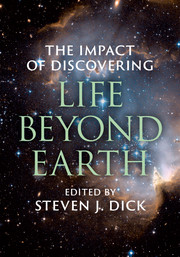Book contents
- Frontmatter
- Dedication
- Contents
- List of contributors
- Introduction: Astrobiology and society
- Part I Motivations and approaches: How do we frame the problems of discovery and impact?
- Part II Transcending anthropocentrism: How do we move beyond our own preconceptions of life, intelligence, and culture?
- Part III Philosophical, theological, and moral impact: How do we comprehend the cultural challenges raised by discovery?
- Part IV Practical considerations: how should society prepare for discovery – and non-discovery?
- 16 Is there anything new about astrobiology and society?
- 17 Preparing for the discovery of extraterrestrial life: are we ready?: Considering potential risks, impacts, and plans
- 18 Searching for extraterrestrial intelligence: preparing for an expected paradigm break
- 19 SETI in non-Western perspective
- 20 The allure of alien life: Public and media framings of extraterrestrial life
- 21 Internalizing null extraterrestrial “signals”: An astrobiological app for a technological society
- Contributor biographies
- Index
- References
18 - Searching for extraterrestrial intelligence: preparing for an expected paradigm break
from Part IV - Practical considerations: how should society prepare for discovery – and non-discovery?
Published online by Cambridge University Press: 05 November 2015
- Frontmatter
- Dedication
- Contents
- List of contributors
- Introduction: Astrobiology and society
- Part I Motivations and approaches: How do we frame the problems of discovery and impact?
- Part II Transcending anthropocentrism: How do we move beyond our own preconceptions of life, intelligence, and culture?
- Part III Philosophical, theological, and moral impact: How do we comprehend the cultural challenges raised by discovery?
- Part IV Practical considerations: how should society prepare for discovery – and non-discovery?
- 16 Is there anything new about astrobiology and society?
- 17 Preparing for the discovery of extraterrestrial life: are we ready?: Considering potential risks, impacts, and plans
- 18 Searching for extraterrestrial intelligence: preparing for an expected paradigm break
- 19 SETI in non-Western perspective
- 20 The allure of alien life: Public and media framings of extraterrestrial life
- 21 Internalizing null extraterrestrial “signals”: An astrobiological app for a technological society
- Contributor biographies
- Index
- References
Summary
Fortune favors the prepared mind.
Louis PasteurFinding many planets in orbit around other stars has provoked new interest in the long-running debate about the existence of extraterrestrial intelligence. Now we are asked to think about what rational, practical steps we can take to prepare for discovering evidence of sapient aliens, an event whose timing and exact nature are unpredictable. Our preparations must be based on probabilities, analogies, and disciplined speculations rather than on confirmed evidence.
Many of those interested in this debate expect that what they see as the final blow to anthropocentrism – discovering extraterrestrial intelligence – is just a matter of time and effort. If that discovery occurs, it might lead to a change in the way we see our status and our position in the universe. Such a discovery might not be the kind of paradigm break that Thomas Kuhn discussed in his famous book, The Structure of Scientific Revolutions (Kuhn 1970). Kuhn was writing about breaking scientific paradigms: replacing one set of physical laws with another. The new paradigms were not just different; they were better. The anticipated discovery of extraterrestrial intelligence is part of a different kind of paradigm break. Contact with an alien civilization would involve much more than science, raising philosophical and societal questions where laws are less certain or non-existent.
Evidence, scenarios, choices
Standards of evidence
A century ago, in the wake of Percival Lowell and the controversy over the canals of Mars, many humans believed that the red planet was inhabited by an alien civilization (Crowe 1986). Subsequent observations discredited that idea; the theory failed the empirical test. Beginning in 1947, thousands of people reported seeing exotic craft in our atmosphere, even on the Earth's surface (Jacobs 1975; Peebles 1994). While large numbers of our fellow humans believed that those objects were visitors from other worlds, most analysts concluded that nearly all UFOs actually were IFOs – identifiable flying objects. As astronomer Seth Shostak pointed out, there still are no artifacts to examine (Shostak 1998, 135). Others have suggested that the sightings most difficult to explain might be unknown phenomena that are unrelated to alien visitors. Again, the empirical standard has not been met.
- Type
- Chapter
- Information
- The Impact of Discovering Life beyond Earth , pp. 286 - 298Publisher: Cambridge University PressPrint publication year: 2015
References
- 2
- Cited by



